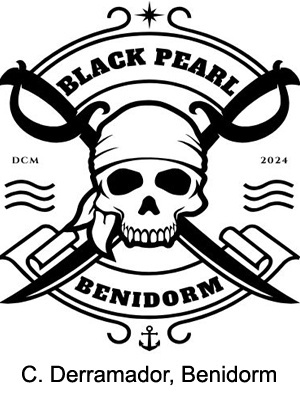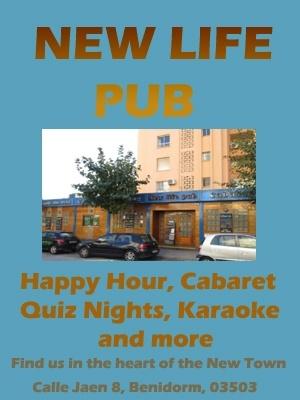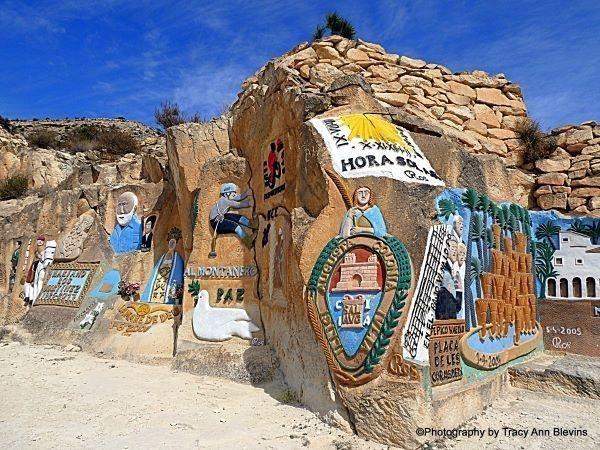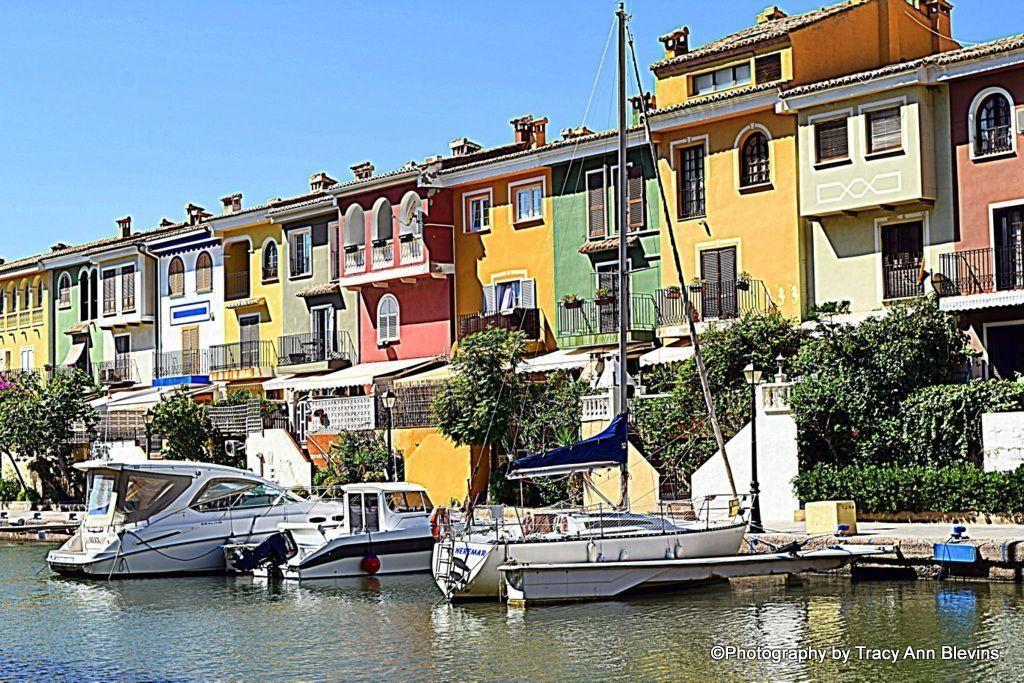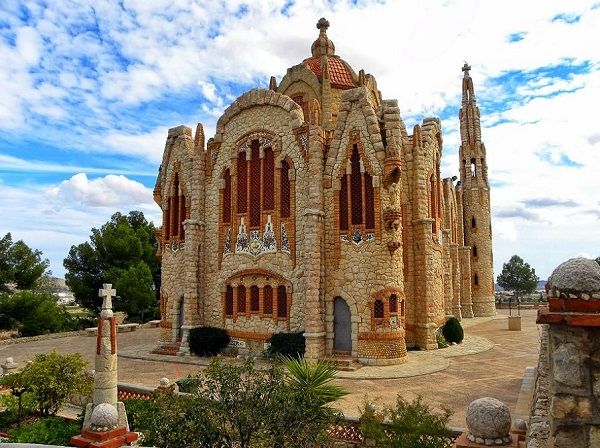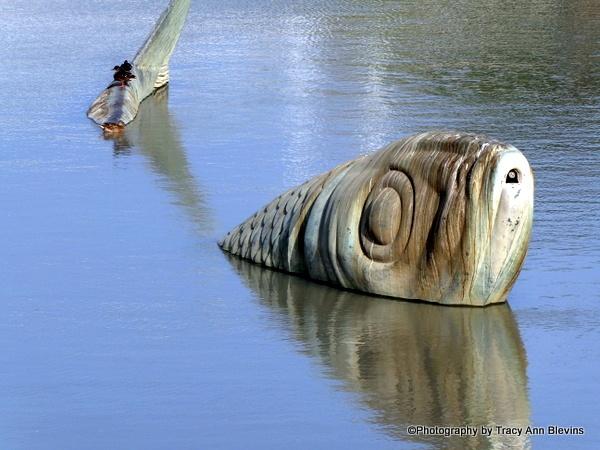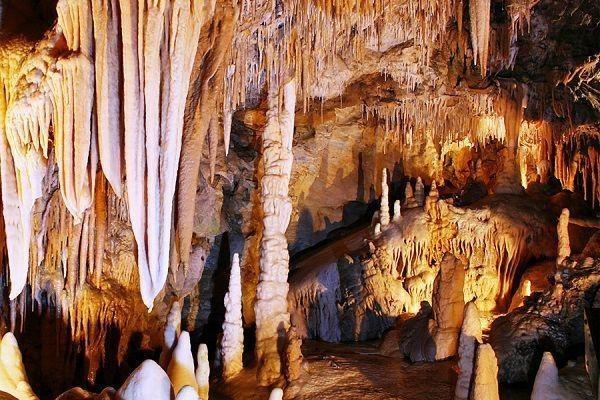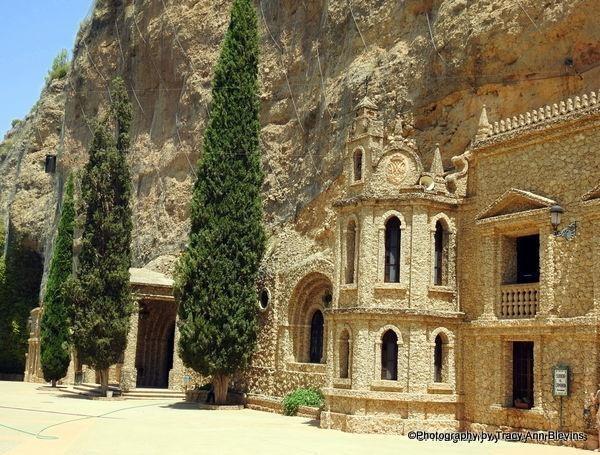All about Alicante
The name of the city comes from the Arabic name Laqant or Al-Laqant, which in turn reflects the Latin Lucentum. The area around Alicante has been inhabited for over 7000 years.
Alicante is a city and port and is the capital of the Alicante Province situated in the south of the Valencian Community. It is also a very historic Mediterranean port.
The population of the city of Alicante in 2022 was estimated at 338,58k, making it the second largest city in the Valencian region, it is also the 8th largest area of Spain.
Alicante is an attractive Spanish city with a castle, old quarter and long waterfront, you will also find lots of museums, most of which are free and well worth a visit.
READ THIS WONDERFUL ARTICLE - Alicante, Montaditos and Fun by Benidorm Seriously member R Colclough
THINGS TO DO IN ALICANTE
suggested routes to get the best out of Alicante in a short period of time.
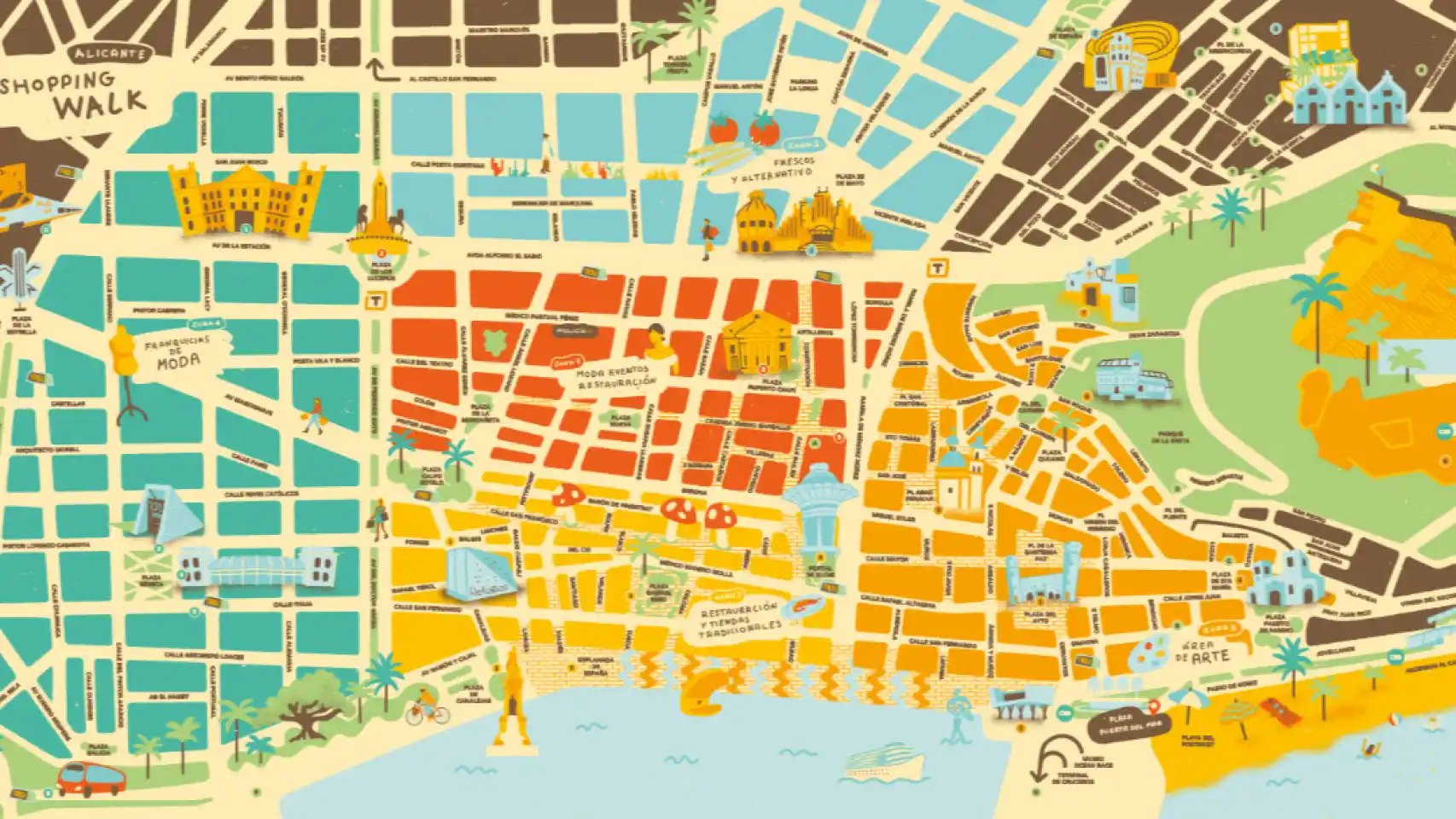
1st route is made up of the downtown area with a wide range of top brand commerce, fashion, events and a variety of restaurants of all kinds.
2nd route, Poeta Quintana Street and around the Central Market, under the 'Fresh and Alternative' route, classifying it as alternative commerce thanks to the differentiation of this area, which has experienced notable growth next to the Central Market.
3rd route includes the establishments around San Francisco Street, popularly known as Mushroom Street.
4th route encompasses the Maisonave area and the adjacent streets around Seneca Square, Fashion Franchises, independent businesses and department stores.
5th route, 'Art Area', runs along Calle Mayor and Villavieja, including in this area the MACA contemporary art museum and establishments specialized in typical crafts.
TAKE A TOUR AROUND ALICANTE ON THE OPEN TOP SIGHTSEEING BUS - NOTE this does not run from early December until mid March.
This is a fantastic and fun way to discover the city of Alicante! Stopping at 12 main places of interest, you can hop on and off wherever you like, or just sit back, relax and enjoy the complete route. The first stop is at the Plaza del Mar by the marina and beach. The bus then heads up to Santa Barbara Castle, the Archaeological Museum, around the old town, the central market, and alongside the port before returning to the Plaza del Mar. Buses run every hour from 10am to 6pm and the tour takes about 50 minutes. There is commentary is in six languages: English, Spanish, Valencian, French, Italian and German.
PRICES: Adults 10€, Children (4-12) 5€, Over 65's 7€
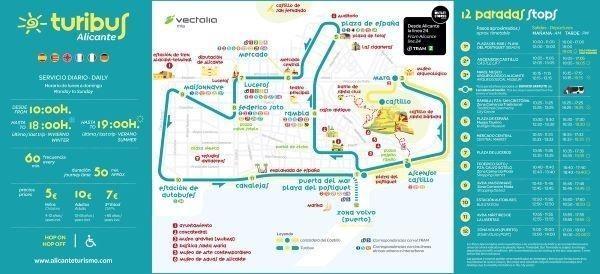
MOUNT BENACANTIL
This is a mount (or rather a large hill) that dominates the urban part of Alicante, and is the characteristic image of the city. 544ft above sea level.
The rock mount is covered by pine trees and bushes on the north side, while on the south side, which overlooks the Mediterranean Sea, there are only rocks. In the intermediate areas there are bushes and grasses that are quite characteristic for the dry climate.
The mount is famous for the rock formation on its south-western slope, known as la cara del moro ("the moor's face").
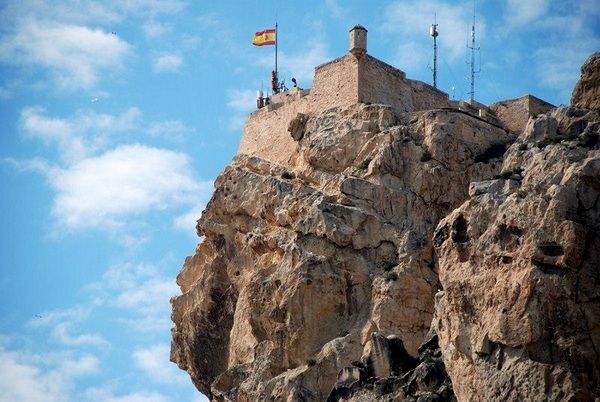
The medieval fortress of Alicante, the Castle of Santa Barbara stands on the top of the mount. On the slopes of the mount there are Park Ereta, neighbourhoods of Santa Cruz, San Roque, San Anton and Raval Roig.
CASTLE OF SANTA BARBARA
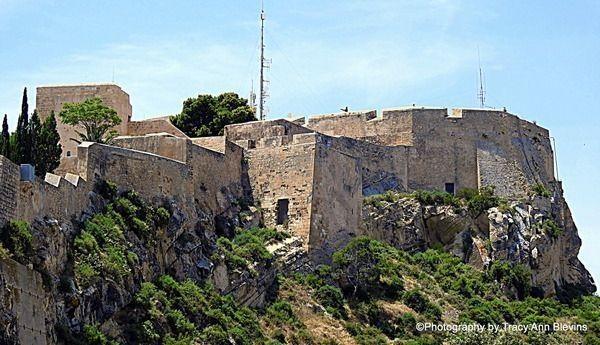
Perched on top of Mount Benacantil, at a height of 166 metres, stands one of Spain’s largest mediaeval fortresses, providing great views of Alicante’s perfect bay.
The castle has three different enclosures from three distinct periods.
The upper enclosure, “La Torreta”, is where visitors will find the keep and the most ancient remains of the fortress, which mostly date from the 14th century.
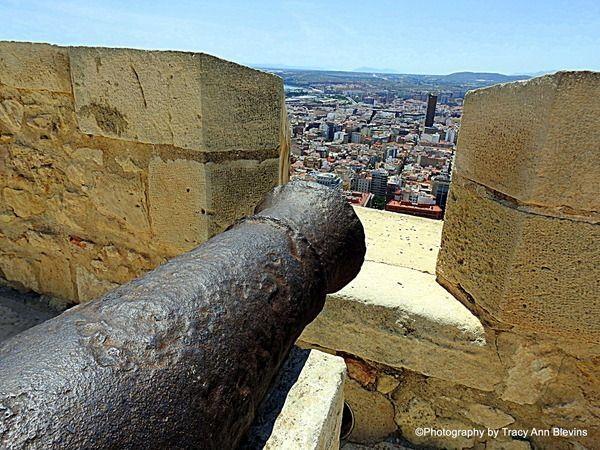
The mid-level enclosure is home to the most important buildings, which were built in the 16th century. These include: The Salón Felipe II hall. The Cuerpo de Guardia guardhouse the Patio de Armas parade ground the Baluarte de la Reina bastion.
The lower enclosure dates back to the 18th century and is home to the Revellín del Bon Repós ravelin.
You can access the castle via a lift built into the rockface opposite El Postiguet beach, or on foot or by car along the road on the north side of Mount Benacantil.
JORGE JUAN STAIRCASE - Located on Avenida General Marvá
These famous steps were built as an access point to the Doctor Rico Park, the woodland area of Monte Tossal, and the Castillo de San Fernando. They later also provided access to the Jorge Juan Institute.
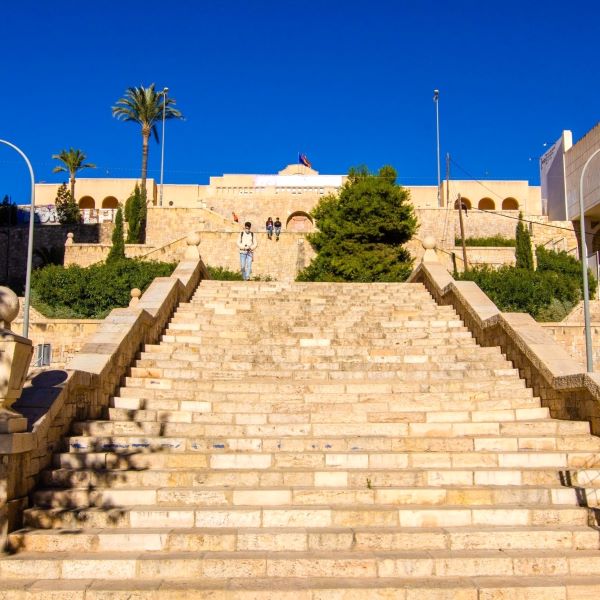
Today, these steps are the entrance point to a beautiful trail where you can explore one of the cities natural spaces, and admire some of the best views of the Alicante skyline.
The complete walk takes about an hour and a half with information points along the way to guide you. Dogs are allowed on a lead, there are benches for resting and picnic and play areas for children. Note there is no disabled access on this route.
ALICANTE PORT
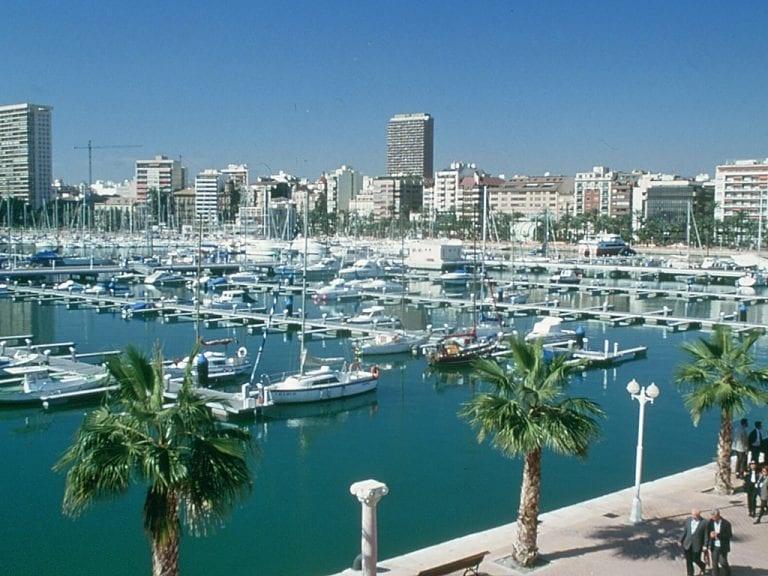
The port has been reinventing itself since the the 1980s. In recent years, the Port Authority has established it as one of the most important ports in Spain for cruises, with 72 calls to port made by cruises, bringing some 80,000 cruise passengers and 30,000 crew to the city each year.
The 1990s marked possibly the greatest changes in the modern history of the port of Alicante. The Special Plan for the Port ('PEP' in Spanish) of 1992 allowed the port to plan an expansion towards the south and made provisions for converting some of the quayside into a zone of seafood restaurants, an extensive promenade with modern bars and nightclubs open until dawn.
EXPLANADA de ESPANA
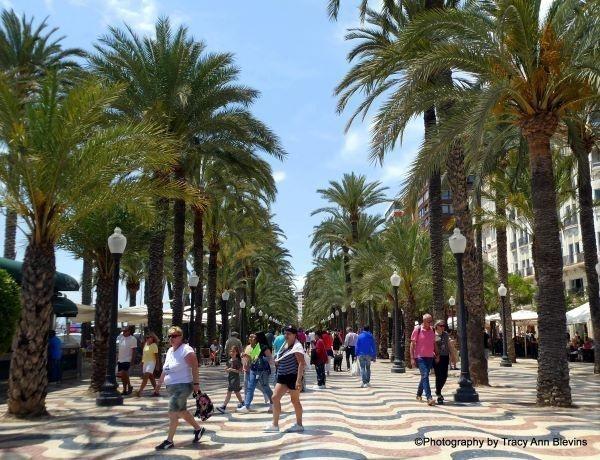
Explanada de Espana - palm avenue along the coast of Mediterranean Sea. Many people consider it as the most beautiful quay in Spain. A wonderful place to sit and watch the world go by. It is paved with 6.5 million marble floor tiles creating a wavy form. The Promenade extends from the Port of Alicante to the Gran Vía and ends at the famous statue of Mark Hersch. At the end of the promenade is a monument by the artist Banuls of the 19th century.
Visit the most photographed street in Alicante
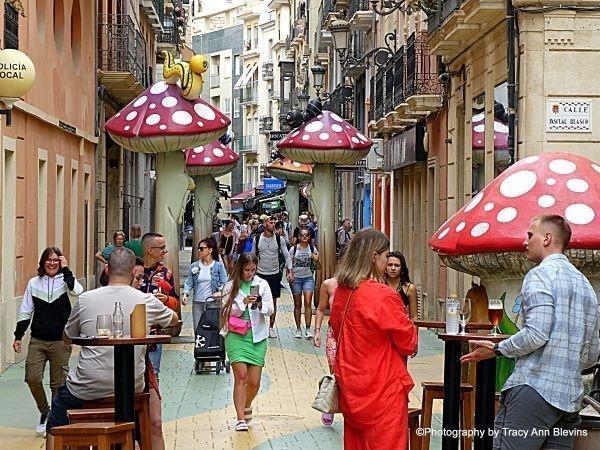
This has been nicknamed the "Mushroom Street" and was designed in 2013 and is now a favourite street for many. The streets real name is calle San Fransisco and it can be found in the old town area.
EL BARRIO
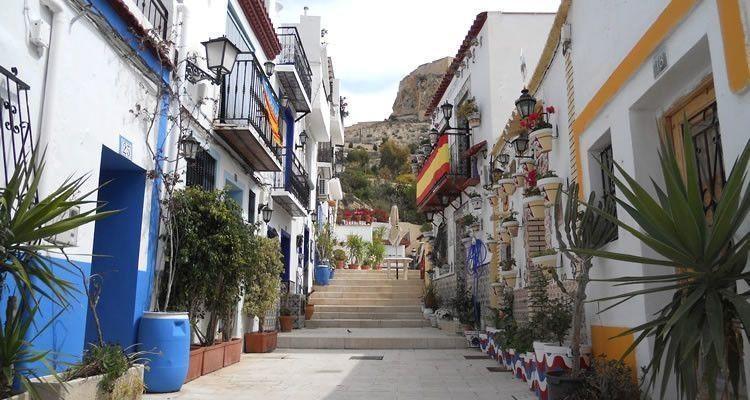
El barrio is the old neighbourhood in Alicante and has with its narrow streets and old buildings a nice area to go for a walk. Built under the protection of the Santa Barbara fortress, and full of narrow, steep streets and colourful buildings.
El barrio is mainly known for its high number of bars and discotheques, but also by daytime it's a nice place to go for a walk to enjoy the beauty of the architecture.
THE SAN NICOLAS CATHEDRAL Alicante
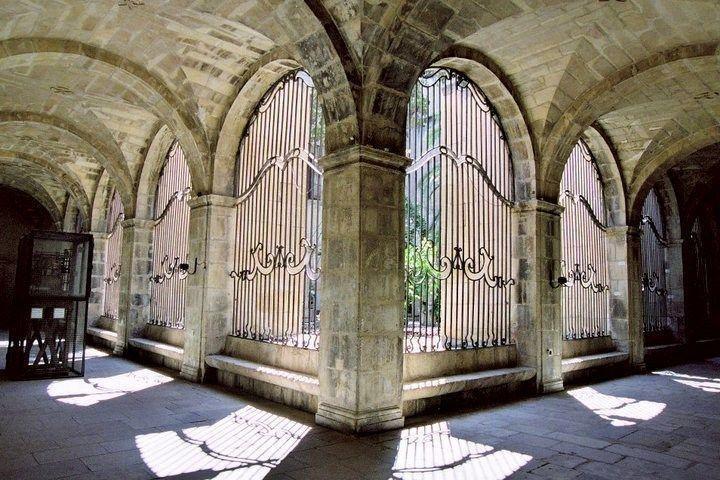
Construction began on the San Nicolás Co-Cathedral in the year 1600, replacing a building that had stood their previously. It is built in the Herrerian renaissance style and is located in the heart of the city.
Its floor plan is in the shape of a Latin cross, with an interior that boasts notable features such as the 15th century cloister with two baroque doors, the altar and the blue cupula 45 metres high. Below the cupola is the Capilla de la Comunión communion chapel, which is considered to be one of the most beautiful examples of Spanish baroque.
The interior has recently been restored to mark the celebration of the La Luz de las Imágenes exhibition (The Light of Images) in Alicante, which aims to recuperate and promote the Region of Valencia’s artistic heritage.
Plaza Abad Penalva, 1
Opening hours: From Monday to Saturday from 11.30 am to 12.30 am from 5.30 pm to 6.30 pm
SANTA MARIA BASILICA - Plaza Santa María
The Santa Maria Basilica is the oldest church in the city, dating back to the 14th century. It was built upon the ruins of Alicante’s biggest mosque and has a single, non-cruciform nave with side chapels between the buttresses.
The basilica was rebuilt following a fire in the 15th century. Its baroque facade is crowned by two asymmetrical towers – one built in the 14th century and the other in the 18th century. The doorway has the image of the Virgin Mary by sculptor Juan Bautista Borja.
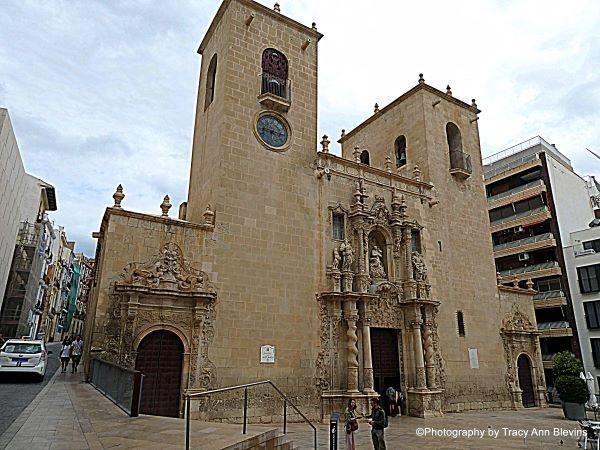
Inside is an 18th century rococo main altar and the Bautismo, Inmaculada and Comunión chapels. The chapterhouse contains an enormous baptismal font from the 16th century and a Valencian baroque organ from 1653.
Opening Times - Monday to Saturday, from 10:00 to 19:00. Sundays: from 14:00 to 19:00, last access time allowed: 40 minutes before closing time.
Entrance Fees (2023)
General (18 to 64 years old): €6.00, Senior (65 years and older): €5.00, Youth/Student (13 to 17 years old, Youth/University Card up to 25 years old): €4.00, Groups (20 people or more): €4.00, schools: €3.00
Park El Palmeral (The palm grove) The park is close to the busy N-332 on Avinguda d'Elx just outside the city centre as the name suggests this is a park full of different palm trees, in fact there are over 7000. You walk on well-kept gravel paths, over bridges, pass beautiful flower beds and rare palms. The gravel paths make this park very accessible for people with prams and wheelchair users. but dogs are NOT permitted.
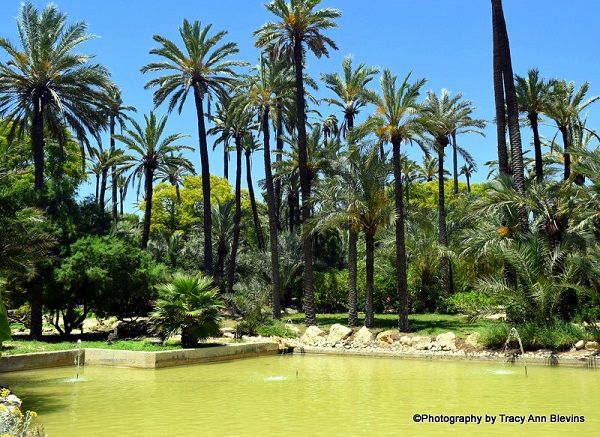
You can also view the park from the water as you can rent a free rowing boat to sail over the beautifully landscaped pond. You just have to sign up at the dock, they will ask for your driver's license or passport and sign that you will return the boat intact. The pond consists of beautiful open spaces and narrow passages.
There is a lovely cafe and plenty of activity areas for children and sports facilities.
The park is open daily from 9 am to 10 pm in winter and 11 pm in summer. The hours for rowing vary depending on the season.
THE PROVINCIAL ARCHAEOLOGY MUSEUM - MARQ - Plza. Dr. Gómez Ulla, 03013 Alicante
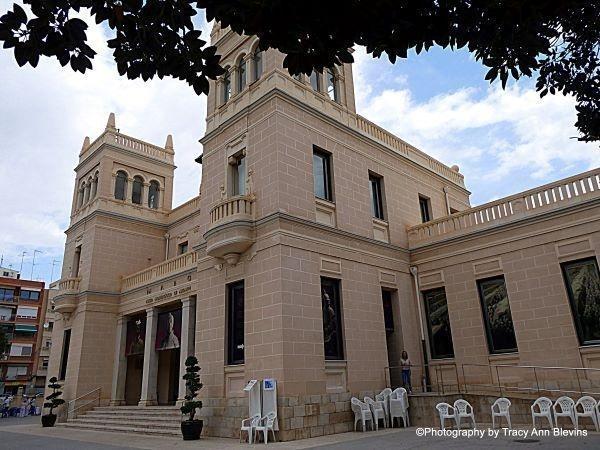
Created in 1932, this museum was originally located on the ground floor of the Provincial Council building on Avenida de la Estación avenue in Alicante. In 2002 it was transferred to the former site of the San Juan de Dios provincial hospital.
Visitors to this highly innovative and visual museum can enjoy an avant-garde approach to archaeology supported by modern audio-visual techniques. Its exhibits stretch from the Palaeolithic through to Contemporary Modern Culture, tracing the history of Alicante. This museum won the European Museum of the Year Award in 2004
2024 Exhibition - From 26th of March, until October 13th. The museum will be holding an exhibition of almost 500 bronze age artefacts, some of which have never before been shown in Spain. The exhibition is a result of collaboration between 21 other museums, who have lent objects which together are said to be of "incalculable value"
OPENING HOURS - Monday, from 9:00 to 14:00. Tuesday to Saturday, from 9:00 to 19:00. Sunday and holidays, from 10:00 to 14:00.
PRICE - General admission 5€, Reduced admission 3€ Book tickets online here.
ALICANTE MUSEUM OF CONTEMPORARY ART (MACA)
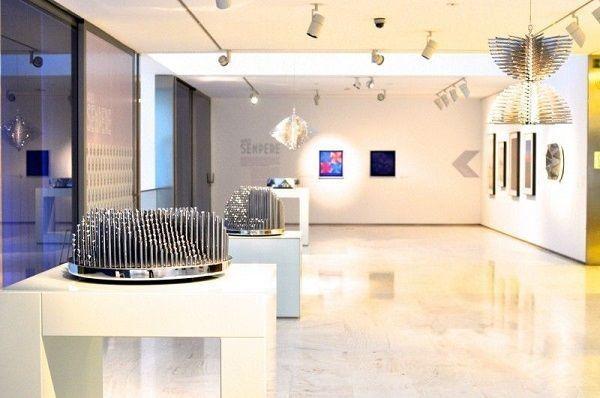
This museum is housed in the city’s oldest surviving civil building. In the baroque style, it dates back to 1685 and is located next to the Santa María basilica. It was originally designed as a cereals warehouse but was also used as a business school before finally becoming a museum.
It has three permanent collections: the collection of 20th-century art, which includes works by Miró, Dalí, Juan Gris and Julio González; the Juana Francés Collection, donated by the artist on her death in 1990; and the Eusebio Sempere Collection, acquired by Alicante Town Council since 1997.
Opening hours - From October to May Tuesday to Saturday from 10.00 to 20.00 h. Sundays and holidays from 10.00 to 14.00 h. Closed on Mondays. June, July, August and September: Tuesday to Saturday from 11:00 to 14:00 h and from 18:00 to 20:45 h. Mondays, Sundays and holidays from July, August and September CLOSED. FREE admission
GRAVINA FINE ARTS MUSEUM (MUBAG)

This museum occupies the 18th century Gravina Palace, which once belonged to the Count of Lumiares and housed the Provincial Archives. It exhibits works owned by the Provincial Council of Alicante, with collections comprising works of art created in Alicante from the Middle Ages through to the early 20th century.
Address: c/ Gravina, 13 – 15 (Old Quarter) Phone:(+34) 965 14 67 80
Opening hours: July and August: Tuesdays to Sundays from 11.00 to 21.00 h. Sundays and holidays from 11.00 to 15.00 h. Closed on Mondays.
Rest of the year: Tuesdays to Saturdays from 10.00 to 20.00 h. Sundays and holidays from 10.00 to 14.00 h. Closed on Mondays. FREE admission
Shopping centres in Alicante
Centro Comercial Panoramis - Muelle de Pte., 6, 03001 Alicante
Gran Vía Shopping Center - Calle José García Sellés, 2, 03015 - Alicante
Centro Comercial Puerta de Alicante - Avinguda de Alcalde Lorenzo Carbonell, s/n, 03007 Alacant
El Corte Inglés - Av. Federico Soto, 1, 03003 Alicante
Plaza Mar 2 - Hermanos López Osaba, 03013 Alicante
Centro Comercial Fontana - Av. Holanda, s/n, 03540 Alicante
Please note Shops in the area are not open every Sunday but selected dates over the year.
And of course, don´t forget the BEACHES
Postiguet Beach
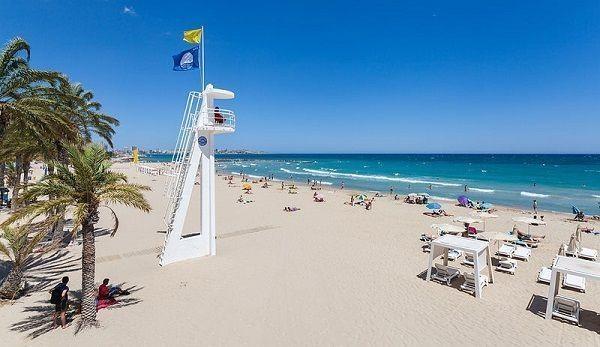
This beach is located in Alicante’s city centre, at the foot of Santa Barbara Castle and next to the marina and the Explanada de España.
San Juan Beach
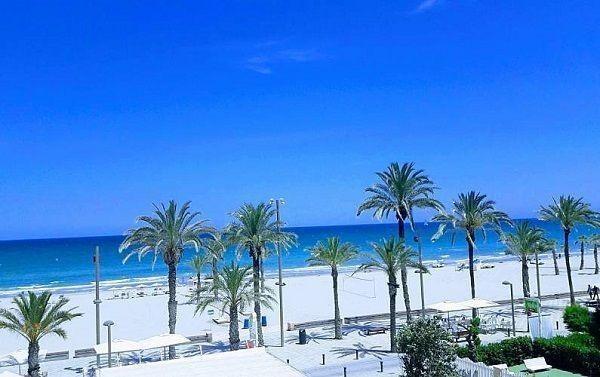
Almost 3 kilometres of golden sand make San Juan the most popular beach in Alicante. This is a long open beach with high quality fine sand.
La Almadraba Beach
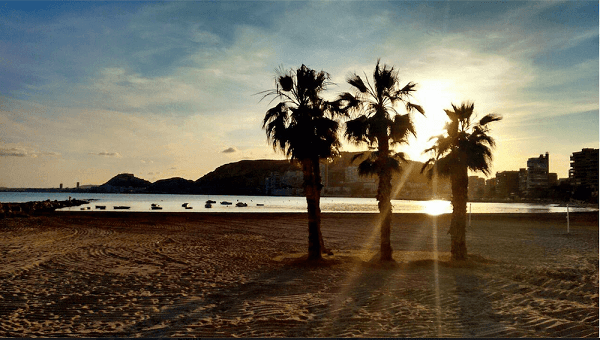
A small uncrowded beach, ideal for rest and relaxation. The sea here is tranquil with no waves and it’s the perfect place for watching a sensational sunset.
Cabo de la Huerta Coves
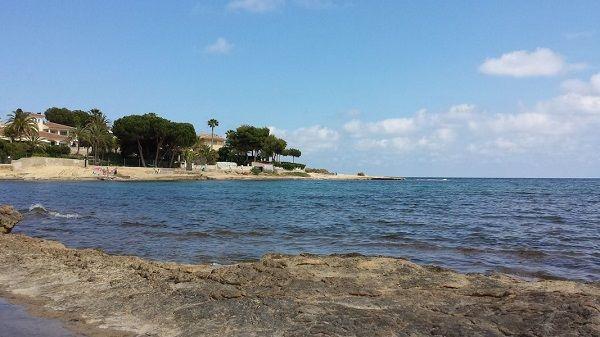
Between the beaches at Almadraba and San Juan, rocks and sand form these beautiful coves with clear water.
Located to the northeast of the city of Alicante, between the Serra Grossa and Tossal de Manises, in an area with important archaeological sites. This is where the city’s origins lie.
Saladares Urbanova Beach
This beach is located 5 km from Alicante city center. It is situated in a quiet area, with plenty of services for visitors and signposted nudist areas.
How to get to Alicante from Benidorm
Discover Alicante with Round Town Travel
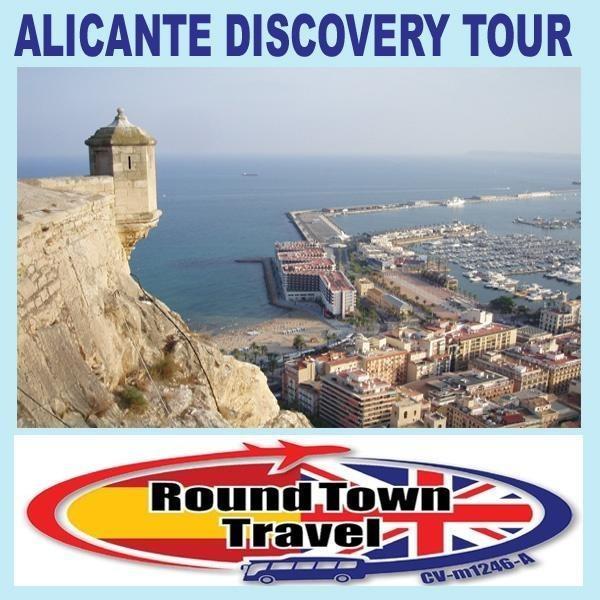
Details on how to get to Alicante by Train/tram from Benidorm can be found HERE
Alsa bus also provide a regular service from Benidorm to Alicante
Beniconnect ALITREN, takes you to the centre and drop off /picks up at the train station. Only 10 euros Book Beniconnect here
A TRIP TO TABARCA from Alicante
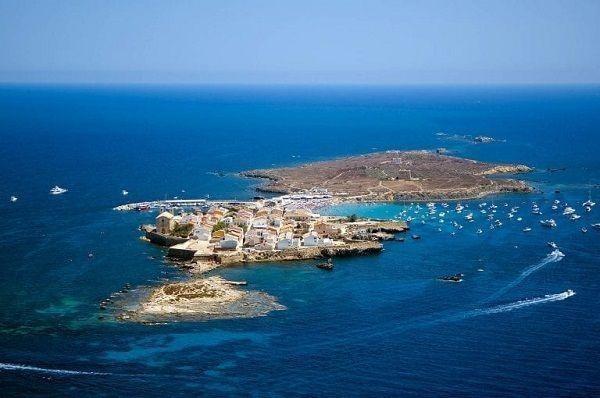
The island’s waters are officially declared a Mediterranean Marine Reserve for their excellent quality and for the biodiversity of their flora and fauna.
Tabarca is the only inhabited island in the Region of Valencia and is located opposite the city of Alicante, 11 nautical miles offshore and near the Santa Pola headland. In fact, it’s more than just an island: it’s a small archipelago that comprises the islets of La Cantera, La Galera and La Nao as well as the Isla de Tabarca itself. It is approximately 1,800 metres long and measures some 400 metres across at its widest point.
In the past, its shores were a refuge for Berber pirates, and, in the 18th century, King Carlos III ordered the island to be fortified and a town built, in which to house several families of Genoese fishermen who were being held prisoner in the Tunisian city of Tabarca.
The walls surrounding the town have been officially declared a Historical and Artistic Site and an Asset of Cultural Interest.
A visit to the island usually lasts one day. There are numerous departure times from the port of Alicante, although the regularity of these depends upon the time of year. The boat ride is comfortable and lasts for around one hour. The island can also be reached from Santa Pola and Benidorm.
Museum Nueva Tabarca - Tabarca island. Almacén de la Almadraba Building.
Winter: Wednesday to Sunday. From 11.00 to 14.00 h. From 15.30 to 16.30h.
Summer: Wednesday to Sunday. From 11.00 to 14.00 h. From 16.00 to 18.30h.
General ticket: 2 €. Reduced ticket: 1 € for arranged groups of students of more than 10 people and adults with student card. Free admissión for people older than 65 years, and children up to 12 years accompanied or handicapped.
The boat trip to the Tabarca Island can be comfortably made from Alicante, Santa Pola, Guardamar and Benidorm.
From Alicante Marina
Timetables:
At Easter and over the summer season, there are several departures every day.
Outside of the summer season, confirm timetables beforehand:
| Invierno-Hiver-Winter |
| Alicante- Tabarca
From Monday to Sunday |
| Tabarca-Alicante
From Monday to Sunday |
Approximate journey time: 1 hour. Children over 4 years and adults: 19€ Children under 4 years: free
Once on the island, visitors can enjoy the coves and beaches with their crystal-clear waters and a picturesque fishing port with excellent eateries offering the opportunity to try the traditional “caldero”, the island’s typical dish.
We recommend a stroll through the town and a visit to the island’s museum.
Visitors can now even enjoy an overnight stay on the island, thanks to the recent opening of accommodation.
Find details of other places to visit in this section of the website - The surrounding area. Like us on Facebook


